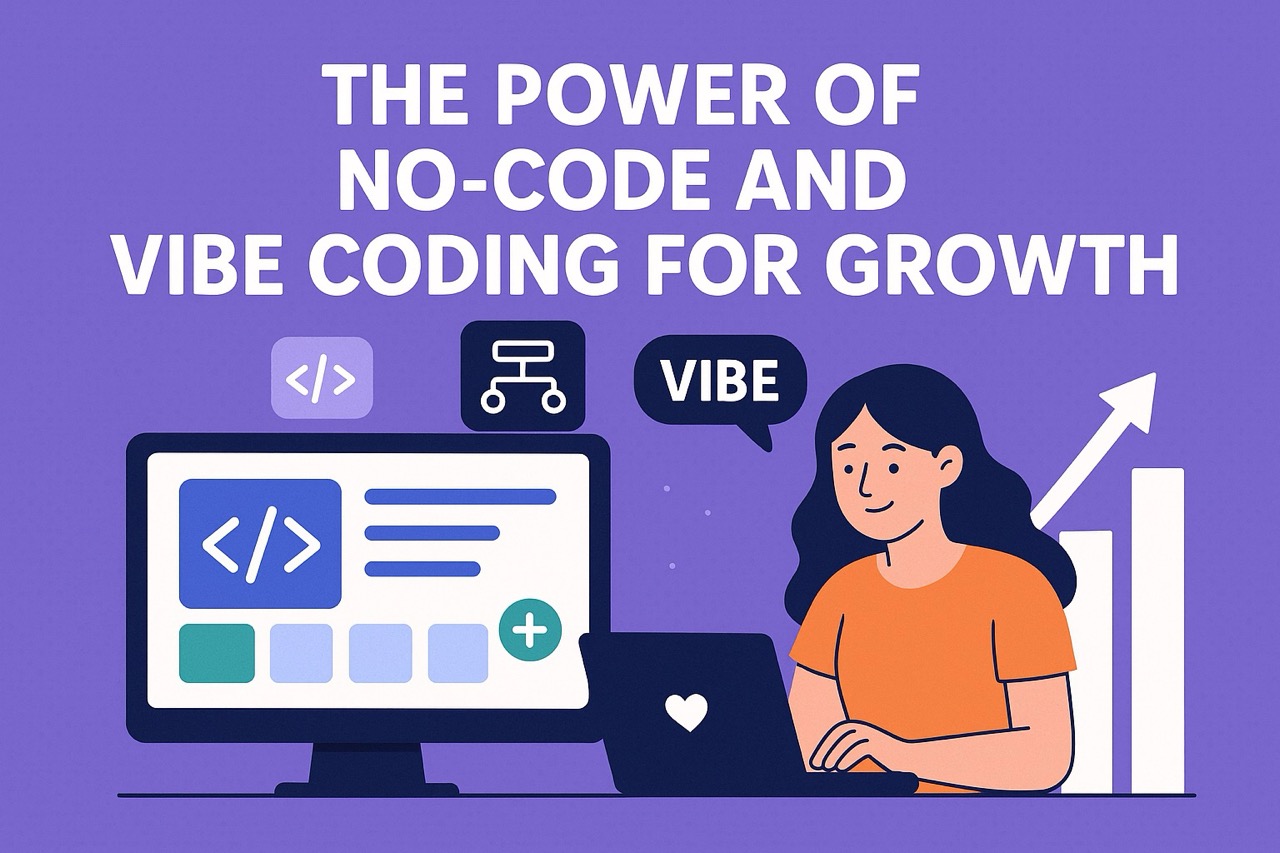The Power of No-Code and Vibe Coding for Growth
The demand for digital speed has never been higher.
Yet, development teams are often bogged down by technical debt, slow release cycles, and the high cost of custom software. For large, complex organizations like yours, the pressure to innovate while maintaining reliable, massive-scale operations is a constant challenge.
This is where a strategic approach to two emerging development paradigms—No-Code and Vibe Coding—becomes essential to accelerating your competitive advantage.Decoding No-Code: Speed, Governance, and Accessibility
No-Code development is fundamentally a visual approach to building software. It empowers non-technical users and domain experts (often called “Citizen Developers”) to create functional applications, websites, and automations without writing a single line of code.
How It Works:
Instead of typing out commands, users build by dragging pre-built components (like forms, buttons, or database connectors) onto a visual canvas and connecting them with logic flows.
The Strategic Advantage for Enterprises:
- Rapid Time-to-Value: No-Code allows teams to ship systems in hours or days, not months. This is perfect for internal tools, departmental workflows (e.g., HR, operations, internal reporting), and quick-turnaround marketing campaigns that need to launch quickly.
- Shared Visibility and Governance: Because the systems are built visually, every stakeholder—from the product manager to the compliance officer—can easily see and understand how the system works. This shared language reduces miscommunication and speeds up approval processes.
- Reduced Cost of Change: Tweaking a workflow or adding a module is simple and fast, which keeps the system agile as business requirements evolve.
The Caveats to Manage:
No-Code is powerful, but it comes with platform constraints. You are limited to the components and workflows provided by the vendor.
If a feature doesn’t exist, you often must find a workaround or write custom code (moving it into the “Low-Code” space). More critically, an enterprise must manage platform dependency—you are reliant on the vendor’s infrastructure, pricing, and continued existence, which introduces a potential single point of failure and vulnerability.
Scaling costs on usage-based models can also be unpredictable.The ‘Vibe’ Shift: Conversational and AI-Guided Development
If No-Code is like renting a comfortable, pre-built apartment, Vibe Coding is like building your own fully customized house, but with an AI-powered construction crew.
Vibe Coding is an AI-guided software creation method where the developer describes the desired outcome—the “vibe”—in natural language, and a large language model generates functional code, scripts, or agent behaviors.
The term, coined by Andrej Karpathy in early 2025, describes a workflow where the primary role shifts from writing code line-by-line to guiding an AI collaborator.
How It Works (The Conversational Loop):
- State the Intent: A developer provides a high-level prompt in plain language (e.g., “Create a Python function that reads a CSV file and handles errors”).
- AI Drafts the Artifact: The AI generates the initial code.
- Review, Run, and Refine: The developer executes the code, tests it, and provides further feedback (“That works, but add error handling for when the file is not found”).
- Repeat: This tight, conversational loop continues until the code is complete and correct.
The Strategic Edge for High Innovation:
- Unlimited Customization and Full Control: Unlike No-Code, Vibe Coding removes platform limitations, allowing for the creation of unique business logic, custom functionality, and highly specific performance optimization that does not exist in standard patterns.
- Complete Code Ownership: The AI generates code that your company owns completely. This eliminates vendor lock-in, which is a critical consideration for mission-critical, core systems.
- Accelerating Innovation Velocity: Vibe Coding is ideal for innovative applications, AI-powered features, custom algorithms, and rapid prototyping. Developers can prototype features in minutes rather than days, drastically increasing the speed of experimentation.
The Caveats to Manage:
Vibe Coding requires a greater level of technical skill. It is best suited for developers and technical teams who can review, test, and understand the code the AI generates, taking full ownership and responsibility for the final product. While the AI automates much of the boilerplate, engineers are still essential for setting architecture, ensuring security, and debugging complex components.Strategic Synergy: How Companies Can Win
The future of software development for a major enterprise is not a choice between No-Code and Vibe Coding—it is the orchestration of both. Winning organizations will separate the act of creation from the act of orchestration.
- The Hybrid Development Model for Enterprise Scale
Your company can strategically deploy these tools based on risk, complexity, and need for customization:
- Deploy No-Code for Reliability and Internal Operations: Use No-Code platforms to handle reliable, repeatable systems with guardrails. This includes automating internal processes like inventory tracking alerts, marketing campaign setup, HR onboarding workflows, and simple data visualization dashboards. The advantage here is shared visibility, rapid deployment, and governance within a controlled environment.
- Deploy Vibe Coding for Custom Innovation and Core Modernization: Use Vibe Coding to accelerate the work of professional developers. This is where your competitive advantage resides:
- Customer-Facing AI: Generating custom algorithms for personalized product recommendations, dynamic pricing models, or advanced supply chain optimization that require unique business logic.
- Legacy System Modernization: Using the AI generation loop to quickly draft code snippets for migrating or refactoring older systems, accelerating the process of reducing technical debt.
- Building Your Next-Gen Platform: Creating the unique, complex features that cannot be constrained by a No-Code platform, ensuring complete code ownership and scalability.
- Orchestration and Governance
The most critical step is orchestrating these pieces visually. By using visual tools and standards for all No-Code, Vibe Coding, and even traditional Low-Code components, cross-functional teams can understand, operate, and improve the entire automation landscape.
This visual governance is crucial for a large organization to maintain control, manage dependencies, and ensure that rapid development does not become ungoverned chaos.
- Empowering Your Workforce
The hybrid approach allows you to empower your entire workforce:
- Citizen Developers: Non-technical domain experts can solve their own immediate problems, freeing up IT resources for core projects.
- Professional Developers: Engineers shift their focus from writing boilerplate code to guiding the AI, focusing on high-value architecture, security, testing, and system integration.
Conclusion
The evolution of software development is not linear; it is becoming multi-modal. No-Code offers the fastest path to value for internal, non-critical systems, while Vibe Coding offers the ultimate speed and control for innovative, custom, and complex core applications.
By choosing a system that allows you to orchestrate the strengths of both—using No-Code for reliable delivery and Vibe Coding for accelerating innovation—your company will dramatically increase its speed, maintain governance, and be perfectly positioned to capture the next wave of digital opportunity.
The key is to start experimenting now: embrace the hybrid model, define your guardrails, and let your teams build faster, safer, and with unparalleled vision.



